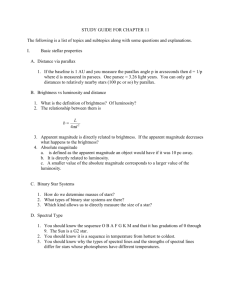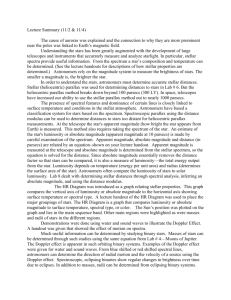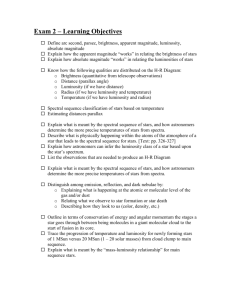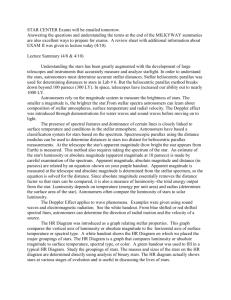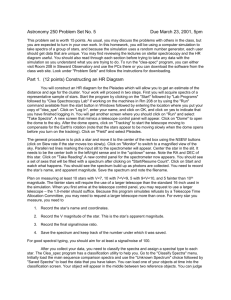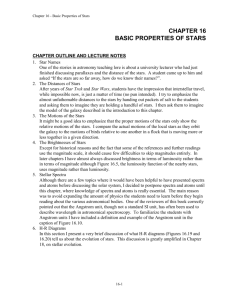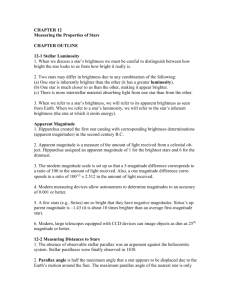Syllabus PHYS530 Topics In Teaching Physics, 3 cr
advertisement
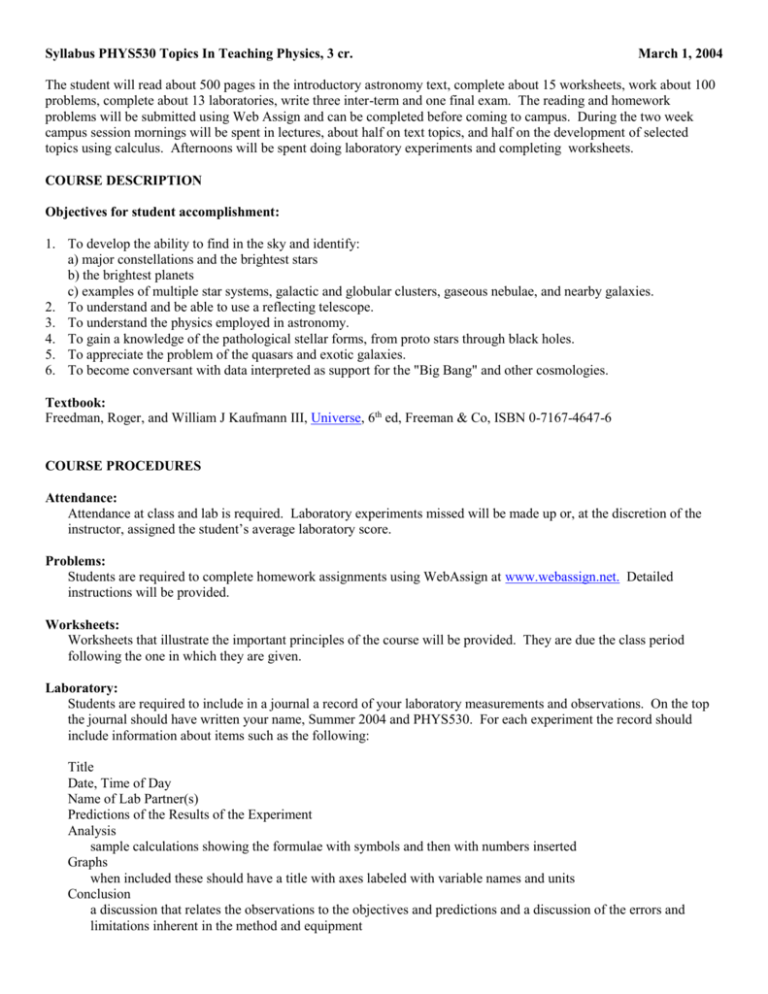
Syllabus PHYS530 Topics In Teaching Physics, 3 cr. March 1, 2004 The student will read about 500 pages in the introductory astronomy text, complete about 15 worksheets, work about 100 problems, complete about 13 laboratories, write three inter-term and one final exam. The reading and homework problems will be submitted using Web Assign and can be completed before coming to campus. During the two week campus session mornings will be spent in lectures, about half on text topics, and half on the development of selected topics using calculus. Afternoons will be spent doing laboratory experiments and completing worksheets. COURSE DESCRIPTION Objectives for student accomplishment: 1. To develop the ability to find in the sky and identify: a) major constellations and the brightest stars b) the brightest planets c) examples of multiple star systems, galactic and globular clusters, gaseous nebulae, and nearby galaxies. 2. To understand and be able to use a reflecting telescope. 3. To understand the physics employed in astronomy. 4. To gain a knowledge of the pathological stellar forms, from proto stars through black holes. 5. To appreciate the problem of the quasars and exotic galaxies. 6. To become conversant with data interpreted as support for the "Big Bang" and other cosmologies. Textbook: Freedman, Roger, and William J Kaufmann III, Universe, 6th ed, Freeman & Co, ISBN 0-7167-4647-6 COURSE PROCEDURES Attendance: Attendance at class and lab is required. Laboratory experiments missed will be made up or, at the discretion of the instructor, assigned the student’s average laboratory score. Problems: Students are required to complete homework assignments using WebAssign at www.webassign.net. Detailed instructions will be provided. Worksheets: Worksheets that illustrate the important principles of the course will be provided. They are due the class period following the one in which they are given. Laboratory: Students are required to include in a journal a record of your laboratory measurements and observations. On the top the journal should have written your name, Summer 2004 and PHYS530. For each experiment the record should include information about items such as the following: Title Date, Time of Day Name of Lab Partner(s) Predictions of the Results of the Experiment Analysis sample calculations showing the formulae with symbols and then with numbers inserted Graphs when included these should have a title with axes labeled with variable names and units Conclusion a discussion that relates the observations to the objectives and predictions and a discussion of the errors and limitations inherent in the method and equipment Chapter Exams: One-period in-class closed book chapter examinations will be given dealing with the preceding five or six chapters as well as material discussed in class during that time. Final Exam: A two-period in-class closed book final examination will be given covering the last five or six chapters and questions similar to those on earlier exams. It will have a structure similar to the chapter examinations. Calculator Policy: Students may use calculators on exams. Grading: The above items will determine the students composite score according to the following structure: Item % of Grade Homework 20% Laboratory 15% Worksheets 15% Chapter Examinations 30% Final Exam 20% Grade Distribution: >100 A+ 94 - 100 A 88 - 94 A- 82 - 88 B+ 76 - 82 B 70 - 76 B- 64 - 70 C+ 58 - 64 C 52 - 58 C- 46 - 52 D+ 40 - 46 D 0 - 40 F Intellectual Honesty: Intellectual dishonesty on the part of the student may result in the student failing the course. Any presentation of the work of others represented as your own constitutes intellectual dishonesty. Eating and drinking is not permitted at any time in the laboratory and classroom areas. Topics will include Celestial Coordinates Constellations Motions of the moon and planets Relation of angle to size and distance Eclipses Newton’s laws of motion Newton’s law of gravity Kepler’s laws Energy and velocity in elliptical motion Electromagnetic radiation Properties of photons Black body radiation Acceleration, free fall, motion in polar coordinates Surface gravity, center of gravity examples - vertical rod and horizontal rod Planar motion of central forces, angular momentum, derivation of the laws Escape velocity Energy and momentum Thermal equilibrium, Maxwell Boltzman distribution for discrete energies, Stefan-Boltzman law, Wein’s law Spectra, continuous, emission and absorption Kirchhoff’s laws of radiation Hydrogen Spectrum Bohr’s model of the atom, energies, radii Telescope types and properties Characteristics of the Solar system Asteroids and comets Eccentricities near one Model of solar system formation Properties of the sun Calculation of energy released by proton-proton chain, lifetime of sun Luminosity, absolute magnitude and apparent magnitude of stars Standard candle and standard meter measures of distances to stars Surface temperature, color and spectral characteristics of stars Hertzsprung-Russell diagrams Determination of stellar masses Characteristics of interstellar space Interstellar dark and luminous gas and dust clouds Star formation Open and Globular clusters Modeling stellar life cycles Novae and Supernovae Nucleosynthesis Compact objects-neutron stars and black holes Characteristics of black holes Schwarzschild metric, physics near a black hole Characteristics of our Milky Way galaxy Elliptical and spiral galaxies Galaxy mass Dark matter Seyfert and radio galaxies Quasars Expansion of the universe, Hubble’s law Cosmic microwave radiation Geometry of space time The cosmological constant Size of the universe Models of the time development of the universe Labs 1. Planesphere and Celestial Globe 2. Motions of Moon and Planets 3. Elliptical Orbit of Mars 4. Luminosity of the Sun 5. Rotation of the Sun 6. Telescopes 7. Period-Luminosity Relation 8. 9. 10. 11. 12. 13. Stellar Magnitudes Stellar Parallax Inverse Square Law Hydrogen Spectra Hertzsprung-Russell Diagram Hubble’s Law Homework: Below are problems typical of the level of this course. These are from chapter 17 of Chaisson and McMillan, Astronomy Today, 4th ed. Class lectures will include development of topics occasionally using calculus. A typical assignment would be problems 2, 4, 10, 13 and 14. PROBLEMS Algorithmic versions of these questions are available in the Practice problems module of the Companion Website. [The number of squares preceding each problme indicates its approximate level of difficulty.] 1. _ How far away is the star Spica, whose parallax is 0.013"? What would Spica’s parallax be if it were measured from an observatory on Neptune’s moon Triton as Neptune orbited the Sun? 2. __ A star lying 20 pc from the Sun has proper motion of 0.5"/yr. What is its transverse velocity? If the star’s spectral lines are observed to be redshifted by 0.01 percent, calculate the magnitude of its three-dimensional velocity relative to the Sun. 3. _ What is the luminosity of a star having three times the radius of the Sun and a surface temperature of 10,000 K? 4. _ A certain star has a temperature twice that of the Sun and a luminosity 64 times greater than the solar value. What is its radius, in solar units? 5. __ Two stars—A and B, of luminosities 0.5 and 4.5 times the luminosity of the Sun, respectively—are observed to have the same apparent brightness. Which one is more distant, and how much farther away is it than the other? 6. __ Two stars—A and B, of absolute magnitudes 3 and 8, respectively—are observed to have the same apparent magnitude. Which one is more distant, and how much farther away is it than the other? 7. __ Calculate the solar energy flux (energy received per unit area per unit time), as seen from a distance of 10 pc from the Sun. Compare it with the solar constant at Earth. 8. _ Astronomical objects visible to the naked eye range in apparent brightness from faint sixth-magnitude stars to the Sun with magnitude _27. What range in energy flux corresponds to this magnitude range? 9. _ A star has apparent magnitude 4.0 and distance 100 pc. What is its absolute magnitude? 10. _ A star has apparent magnitude 10.0 and absolute magnitude 2.5. How far away is it? 11. __ Using the data shown in Figure 17.7, calculate the greatest distance at which a star like the Sun could be seen using (a) binoculars, (b) a typical 1-m telescope, (c) a 4-m telescope, and (d) the Hubble Space Telescope. 12. ___ In an eclipsing binary, the brightness is observed to drop by 1 percent when the brighter component eclipses the fainter one, and by 10 percent when the fainter component eclipses the brighter one (see Figure 17.21). If the stars lie on the main sequence and their radii follow the law R M, what is the ratio of the smaller mass to the larger one? 13. __ Two stars in an eclipsing spectroscopic binary are observed to have an orbital period of 25 days. Further observations reveal that the orbit is circular, with a separation of 0.3 A.U., and that one star is 1.5 times the mass of the other. What are the masses of the stars? 14. __ Given that the Sun’s lifetime is about 10 billion years, estimate the life expectancy of (a) a 0.2-solar mass, 0.01solar luminosity red dwarf (b) A 3-solar mass, 30-solar luminosity star, (c) A 10-solar mass, 1000-solar luminosity blue giant. 15. ___ Assuming the mass–luminosity relation L _ M4, estimate the mass of the faintest main-sequence star that could be observed at a distance of 50,000 pc by (a) a typical 1-m telescope and (b) the Hubble Space Telescope. (See Figure 17.7.) 11. What information is needed to plot a star on the H–R diagram? 12. What is the main sequence? What basic property of a star determines where it lies on the main sequence? 13. How are distances determined using spectroscopic parallax? 14. Why does the H–R diagram constructed using the brightest stars differ so much from the diagram constructed using the nearest stars? 15. Which stars are most common in the Galaxy? Why don’t we see many of them in H–R diagrams? 16. Which stars are least common in the Galaxy? 17. How can stellar masses be determined by observing binarystar systems? 18. High-mass stars start off with much more fuel than lowmass stars. Why don’t high-mass stars live longer? 19. In general, is it possible to determine the age of an individual star simply by noting its position on an H–R diagram? 20. Visual binaries and eclipsing binaries are relatively rare compared to spectroscopic binaries. Why is this?





